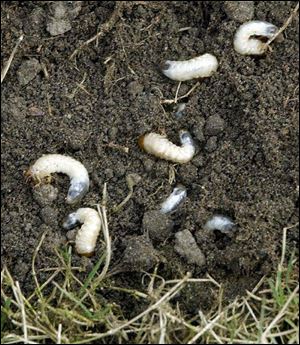
Get the jump on the next wave of grubs
6/25/2003The grass is growing by the minute, and under its roots may be grubs feasting as fast as they can.
“Every lawn can be prone to grubs,” says Mike Reynolds, manager of Black Diamond Lawn Service in Toledo. “People used to think grubs would thrive in sandy or other loose soil, but they can be found in clay soils, too.”
To find out if your turf has a grub problem, dig up a one-square-foot area of sod, peel back the layer of grass, and look at the soil line. If you see more than three or four grubs per square foot of turf, your lawn may be in trouble.
Mr. Reynolds suggests acting before Aug. 15 to control a new generation of the milky white beetle larvae.

Grubs spend much of their time near the soil line.
“Forget about the grubs that are in your lawn now, because they are too big to chemically harm,” Mr. Reynolds says. “These will grow into beetles, then lay their eggs in your lawn again, and that new generation is the one that can be stopped.”
To win the summertime battle against grubs, now is the time to attack. In late June or early July through mid-August, adult beetles emerge from the ground, devour foliage, and lay eggs. The eggs hatch, and the larvae spend the rest of the summer feeding close to the soil line. This is the time they are most vulnerable. By late September and October, they have burrowed deeper and won't return to the surface until after winter.
Mr. Reynolds recommends using a growth regulator containing the active ingredient imidicloprid, which is found in products like Merit or Grub-X.
If you use insecticides to control grubs, check the labels for bendiocarb, carbaryl, diazinon, imidicloprid, or trichlorfon. These chemicals are in many products sold at home and garden stores. Water your lawn after applying insecticides.
Nonchemical grub controls include spreading milky spore disease bacterium (Bacillus popilliae); introducing predatory nematodes (university studies show products containing Steinernema carpocapsae like Biosafe, Biovector, Exhibit, and Scanmask have been marginally effective, and those containing Heterorhabtitis heliothidis are more effective), and landscaping with plants that beetles don't like. Ohio State University experts list these plants among those disliked by adult beetles: arborvitae, baby's breath, begonia, bleeding heart, boxwood, buttercup, caladium, carnation, Chinese lantern plant, cockscomb, columbine, coralbell, coralberry, coreopsis, cornflower, daisy, flowering dogwood, dusty miller.
Also euonymus, false cypress, fir, forget-me-not, forsythia, foxglove, hemlock, holly, hydrangea, juniper, ornamental kale, lilac, lily, magnolia, red or silver maple, mulberry, nasturtium, red or white oak, pine, poppy, snapdragon, snowberry, speedwell, sweet pea, sweet William, tulip tree, violet, pansy, and Taxus yew.
Not too bad. I can see a beautiful landscape forming with those plants and no grubs.